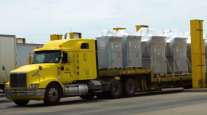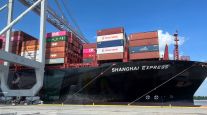Freight Demand to Grow Slowly In 2013, ATA Economist Projects
This story appears in the Dec. 24 & 31 print edition of Transport Topics.
Truck tonnage probably will grow at a slower pace in 2013, but a stronger economic recovery could boost the industry in 2014 and 2015, according to the latest projections from American Trucking Associations.
Bob Costello, chief economist for ATA, predicted a 2% rise in for-hire truck tonnage next year, slowing from the 2.7% increase he projected for 2012.
Costello said during a Dec. 11 webinar for ATA members that tonnage growth has been slowing all year.
The October index reading, for example, fell to 113.7, marking the first decline since 2009. That reading compared with 116.3 last October.
By November, it recovered a bit, rising 1%, ATA said Dec. 17.
Growth is expected to remain slow throughout the first half of 2013, Costello said, because of economic uncertainty. Much of it stems from the so-called “fiscal cliff,” a combination of huge tax increases and spending cuts set to take effect Jan. 1 unless Congress and the Obama administration reach a budget agreement (12-10, p. 1).
“If we can avoid a deep recession [caused by] going off the fiscal cliff, I really believe there is a better economic recovery percolating under the surface, and it will be unleashed in 2014 and 2015,” Costello said.
If the country’s leaders “kick the can down the road” instead of reaching a complete, long-term solution to the fiscal cliff, uncertainty will continue to hurt the economy, he said.
“Not solving the fiscal cliff today is already a drag on the U.S. economy, and nowhere is that clearer than in business investment,” Costello said. “Companies don’t want to go out on a limb hiring more people, investing in more equipment, and so forth, if the whole thing’s going to implode on us because Washington can’t get their act together and we fall back into recession next year.”
And the government’s debt-ceiling limit is coming due in early 2013, as well.
Business investment continues to increase despite slower growth, Costello said, and he sees business spending rising 5.1% next year, compared with the 8.9% gain he projected for this year.
The effects of Superstorm Sandy also must be factored in, but the storm made forecasting a little more difficult because damage estimates are larger than first thought. Costello said the general consensus among economists is growing from $25 billion a week soon after the storm to about $70 billion now.
The estimate led him to predict a “very low” 0.5% annualized growth rate for fourth-quarter gross domestic product. He called the rate at 2% or less for the first two quarters of 2013 and said it will not hit 3% in any quarter of the year.
Those forecasts assume the country does not go off the fiscal cliff, Costello said.
Yet the outlook for the housing market and auto sales, traditional leaders of a U.S. recovery, is improving.
Costello predicts housing starts will surge 28% to 980,000 next year from a projected 767,000 for 2012.
“This is one of the reasons why I’m kind of excited about flatbed freight. Even if you’re a flatbed carrier and you’re not hauling construction material, this is still going to help you, in that it’s going to suck up capacity,” he said.
As for new light-vehicle sales, his prediction is the year will end with an increase to 14.4 million, up 13% from last year, and will grow an additional 5% to 15.1 million next year, simply from “a lot of pent-up demand.”
But projected gains in housing and autos are not enough to alleviate all the downward pressure that lower factory output, slower consumer spending and inventory accumulation will put on the economy.
Consumer spending on goods has been held back by “lackluster job growth” and “subdued” wage growth, Costello said.
He said he forecasts 2.6% growth in consumer spending in 2013, slower than the 4.4% growth rate he projected for this year.
On the industrial side, he predicts factory output will slow to 2.1% growth in 2013, down from 4.4% in 2012.
Nevertheless, Costello said, he sees potential for U.S. manufacturing to pick up in the long term as technology improves production, making competing with wages in China and India less of an issue.
“We could actually see a longer-term trend of more manufacturing back in the U.S.,” he said, “but we’re still going to have to go through some pain before we can get there.”




